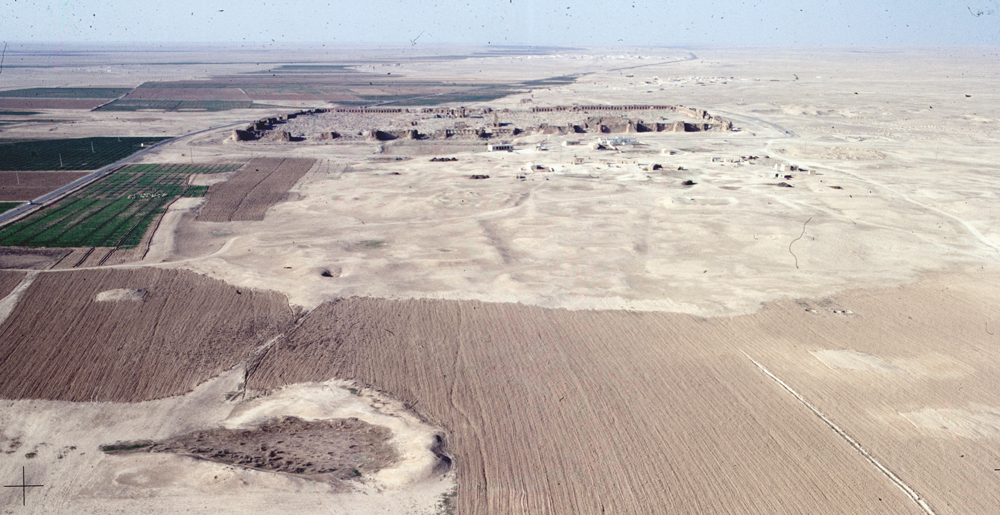One of the main research topics of this project was the analysis of urban development in a semiarid environment. Thus the colonization of a marginal habitat and its determining factors was an important focus of research.
Research
Resafa in Northern Syria lies in the semiarid steppe zone approximately 25 km south of the Euphrates. Despite difficult environmental conditions without fresh water sources and only seasonal rain fall a settlement was founded and later enlarged several times: At the site of a former Roman castrum of the Eastern Limes a pilgrimage city developed in Late Antiquity and in early Islamic period a caliphal residence was established. This is testified by the archaeological remains, proving a continuous settlement from the middle of the 1st century CE until its abandonment in the last third of the 13th century CE. To allow the survival of the settlement, the site had to be ‘customized’ with substantial effort to cover the needs of its inhabitants in the respective stages. Thus, several adaptation processes to cope with the natural conditions are clearly visible in the archaeological record.

Resafa, walled city and settlement remains in its surrounding, view from the south | Photo: M. Stephani/DAI, 1999
Results
The impulse to develop a large settlement in Resafa was not caused by the conditions of the site itself. On the contrary, strategic considerations led to the colonization of a site, which would have not been chosen otherwise, due to its unfavorable environmental situation. It is obvious that the foundation of Resafa, its phases of growth as well as its end, have been steered by outside political powers and were independent from advantages or disadvantages of the natural condition of the site.
To allow the survival at this place the natural resources of the site were exploited and the natural conditions of Resafa and its surroundings gradually altered into a cultural landscape. For example, the skillful exploitation of the site for water harvesting: Large cisterns and dams for channeling the seasonal run off were installed and maintained, the landscape was transformed by the layout of settlements and their infrastructural requirements. Also sedimentary processes caused by human presence and activities led to a transformation of the landscape. The whole site was adapted to fulfill the needs of the settlement, but the basic environmental conditions e.g. climatic factors remained relatively stable on the long term. Based on the preconditions of the natural resources and the cultural background of the respective period a rich material culture evolved, created by actors with highly developed technological skills and a complex social organization. The analysis led to the conclusion, that the intrinsic mechanisms of the respective societal organization are the decisive factors of the colonization processes, in which adaptation strategies for the colonization of a marginal habitat were developed – despite unfavorable natural conditions: Mind over Matter.
Research results have been presented in various publications e.g.
Martin Gussone, “Rusafat Hisham, Syria. New Insights regarding the Caliphal Residence of Hisham b. Abd al-Malik and Ghassanid Sedentarisation”, in: Barbara Horejs, Christoph Schwall, Marta Luciani, Markus Ritter, Mattia Guidetti, Roderick B. Salisbury and Teresa Bürge (Eds.), Proceedings of the 10th International Congress on the Archaeology of the Ancient Near East, 25–29 April 2016, Vienna, Wiesbaden: Harrassowitz Verlag, 2018, 615–628
Wiebke Bebermeier, Dennis Beck, Iris Gerlach, Torsten Klein, Daniel Knitter, Kay Kohlmeyer, Jan Krause, Dirce Marzoli, Julia Meister, Bernd Müller-Neuhof , Claudia Näser, Philipp von Rummel, Dorothée Sack, Stephan G. Schmid, Brigitta Schütt and Ulrike Wulf-Rheidt, “Ancient Colonization of Marginal Habitats. A Comparative Analysis of Case Studies from the Old World”, in: Space and Knowledge. Topoi Research Group Articles, eTopoi. Journal for Ancient Studies, Special Volume 6 (2016), 1–44
Martin Gussone, “Resafa – Ruṣāfat Hišām, Siedlung und Residenz. Ergebnisse zur relativen Chronologie der Siedlungsreste und ihre Auswirkung auf die Interpretation der Kalifenresidenz”, in: Dorothée Sack, Daniela Spiegel and Martin Gussone (Eds.), Wohnen – Reisen – Residieren. Herrschaftliche Repräsentation zwischen temporärer Hofhaltung und dauerhafter Residenz in Orient und Okzident, Petersberg: Imhof Verlag, 2016, 125–138
Martin Gussone, “Zur Methodik der Interpretation, multidisziplinärer Prospektionsergebnisse‘ in Resafa, Syrien” in: Undine Lieberwirth and Irmela Herzog (Eds.), 3D-Anwendungen in der Archäologie. Computeranwendungen und quantitative Methoden in der Archäologie. Workshop der AG CAA und des Exzellenzclusters Topoi 2013, Berlin: Edition Topoi, 2016, 129–156
Related links
- Research project Topoi I (2007 – 2012): Resafa – Rusafat Hisham. The residence of Caliph Hisham b. Abd al-Malik (rgn. 724 – 743 AD)
- Deutsches Archäologisches Institut: www.dainst.org/projekt/-/project-display/52384
- Technische Universität Berlin: http://bauforschung-denkmalpflege.de/resafa/
